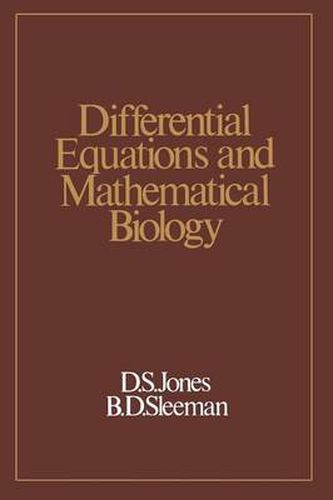Readings Newsletter
Become a Readings Member to make your shopping experience even easier.
Sign in or sign up for free!
You’re not far away from qualifying for FREE standard shipping within Australia
You’ve qualified for FREE standard shipping within Australia
The cart is loading…






This title is printed to order. This book may have been self-published. If so, we cannot guarantee the quality of the content. In the main most books will have gone through the editing process however some may not. We therefore suggest that you be aware of this before ordering this book. If in doubt check either the author or publisher’s details as we are unable to accept any returns unless they are faulty. Please contact us if you have any questions.
Over the past decade, mathematics has made a considerable impact as a tool with which to model and understand biological phenomena. In return, biology has confronted the mathematician with a variety of challenging problems which have stimulated developments in the theory of nonlinear differential equations. This book is the outcome of the need to introduce undergraduates of mathematics, the physical and biological sciences to some of those developments. It is primarily directed towards students with a mathematical background up to and including that normally taught in a first-year physical science degree of a British university (sophomore year in a North American university) who are interested in the application of mathematics to biological and physical situations. Chapter 1 is introductory, showing how the study of first-order ordinary differential equations may be used to model the growth of a population, monitoring the administration of drugs and the mechanism by which living cells divide. In Chapter 2, a fairly comprehensive account of linear ordinary differential equations with constant coefficients is given. Such equations arise frequently in the discussion of the biological models encountered throughout the text. Chapter 3 is devoted to modelling biological pheno mena and in particular includes (i) physiology of the heart beat cycle, (ii) blood flow, (iii) the transmission of electrochemical pulses in the nerve, (iv) the Belousov-Zhabotinskii chemical reaction and (v) predator-prey models.
$9.00 standard shipping within Australia
FREE standard shipping within Australia for orders over $100.00
Express & International shipping calculated at checkout
This title is printed to order. This book may have been self-published. If so, we cannot guarantee the quality of the content. In the main most books will have gone through the editing process however some may not. We therefore suggest that you be aware of this before ordering this book. If in doubt check either the author or publisher’s details as we are unable to accept any returns unless they are faulty. Please contact us if you have any questions.
Over the past decade, mathematics has made a considerable impact as a tool with which to model and understand biological phenomena. In return, biology has confronted the mathematician with a variety of challenging problems which have stimulated developments in the theory of nonlinear differential equations. This book is the outcome of the need to introduce undergraduates of mathematics, the physical and biological sciences to some of those developments. It is primarily directed towards students with a mathematical background up to and including that normally taught in a first-year physical science degree of a British university (sophomore year in a North American university) who are interested in the application of mathematics to biological and physical situations. Chapter 1 is introductory, showing how the study of first-order ordinary differential equations may be used to model the growth of a population, monitoring the administration of drugs and the mechanism by which living cells divide. In Chapter 2, a fairly comprehensive account of linear ordinary differential equations with constant coefficients is given. Such equations arise frequently in the discussion of the biological models encountered throughout the text. Chapter 3 is devoted to modelling biological pheno mena and in particular includes (i) physiology of the heart beat cycle, (ii) blood flow, (iii) the transmission of electrochemical pulses in the nerve, (iv) the Belousov-Zhabotinskii chemical reaction and (v) predator-prey models.